Up Next
Sculptor Heidi Lau on ‘World-Building’ With Personal Memory and Ancient Myth
'A Cacophony of Rocks,' the artist's debut solo exhibition with Sikkema Jenkins, is now on view.
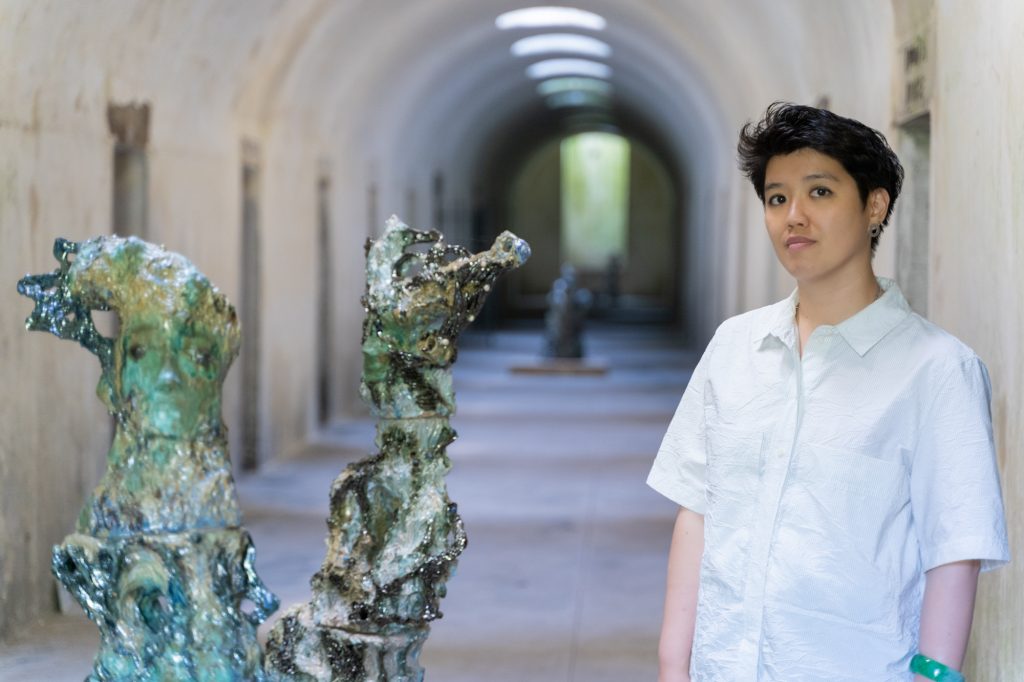
'A Cacophony of Rocks,' the artist's debut solo exhibition with Sikkema Jenkins, is now on view.

Katie White

In the ancient Chinese text, Shanhaijing (The Classic of Mountains and Seas) a dragon named Zhulong manifests the days and nights by blinking her eyes. Night descends as her eyes close. As she opens her eyes, the day rises. The powerful dragon is a guardian of time itself, and her intimate, small gestures form a cosmic order.
Artist Heidi Lau draws from the classical stories of Shanhaijing—and the myth of Zhulong (whom Lau calls Z)—in her deeply evocative new sculptural work now on view in “A Cacophony of Rocks” at Sikkema Jenkins, New York (through March 15). The exhibition is a startling and intimate investigation of the permeability of time and death as seen through the lens of Taoist belief and Chinese myth.
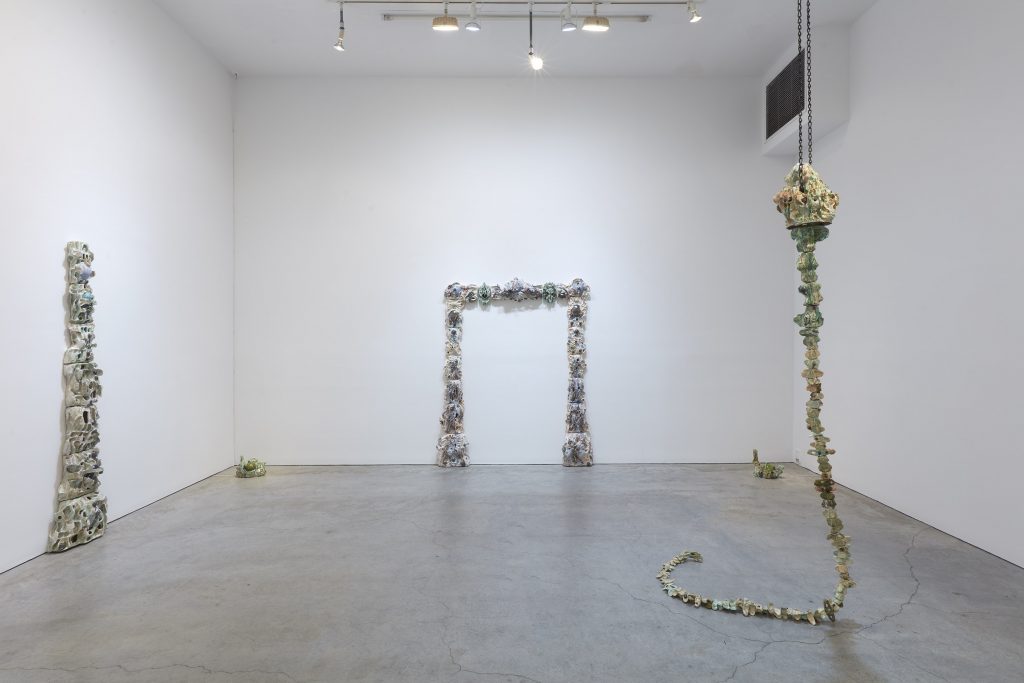
Installation view “Heidi Lau: A Cacophony of Rocks” Sikkema Jenkins & Co., New York, 2024 Photograph by Jason Wyche. © Heidi Lau, courtesy of Matthew Brown and Sikkema Jenkins & Co.
“I have been studying The Classic of Mountains and Seas for the last few years,” the artist said in conversation at the gallery. “There are hundreds of creatures and landscapes described in the text, but for this show, I decided I wanted to recreate a candle dragon.”
Lau (b. 1987) is a self-taught ceramicist, and she hand-built every small component of the 18 sculptures across the back two rooms of Sikkema Jenkins. Lau earned a BFA from NYU in 2008 and came to ceramics after grappling with the limits of two-dimensional representation. In 2021, she was named the inaugural artist-in-residence at Green-Wood Cemetery. Her works have previously been shown at the Museum of Arts and Design, NY; the Bronx Museum of Art, NY; and the Macau Museum of Art. In this exhibition, her works range from totemic large-scale sculptures to intimately-scaled vessels, but are unified by an undulating, almost vegetal sensibility, and together form what feels like a private rock garden.
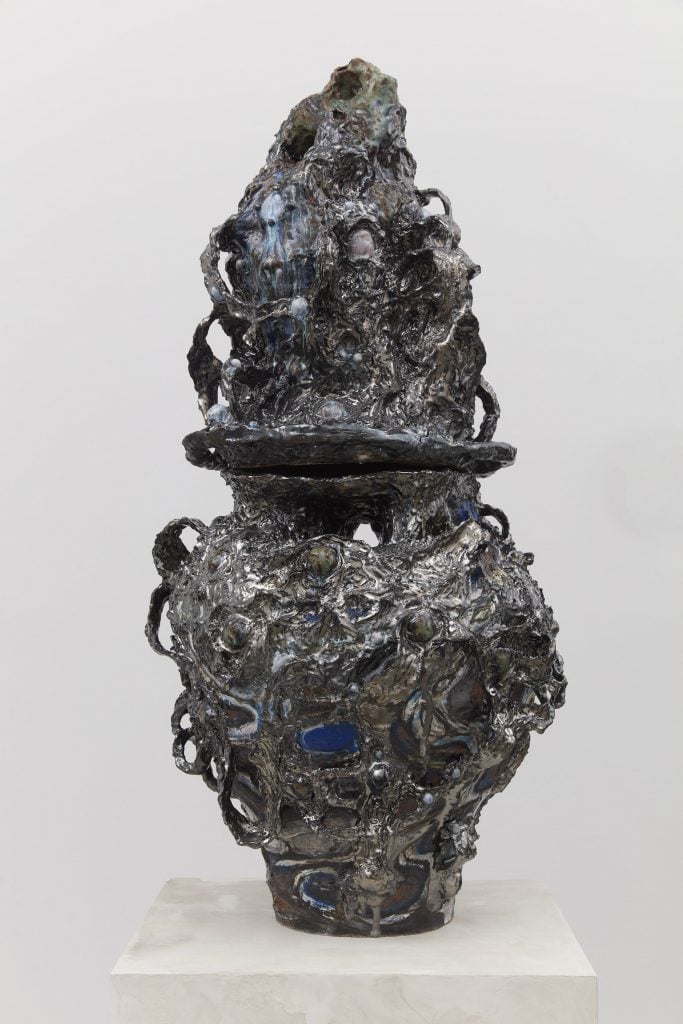
Heidi Lau, Mercury Orbs Vessel (2024). Photograph by Jason Wyche. © Heidi Lau. Courtesy of Matthew Brown and Sikkema Jenkins & Co.
Most of the works are made from clay, a material choice that is imbued with significance, carrying in its very matter the geologic history of life on Earth. Lau’s reworking of the clay becomes a way of negotiating her relationship with her own history and memories.
“Vessels are a kind of world-building,” said Lau in the first room of the exhibition. Here, sculptures, often with the appearance of large urns, are displayed on pedestals. Their surfaces are fabulous, teeming with chimerical animals, flowers, colonnades, and shimmering with celadon green, pale peachy pink, and black mercury glazes. At times, glass components accent the works. In other works, small sculptural bodies of bronze appear.
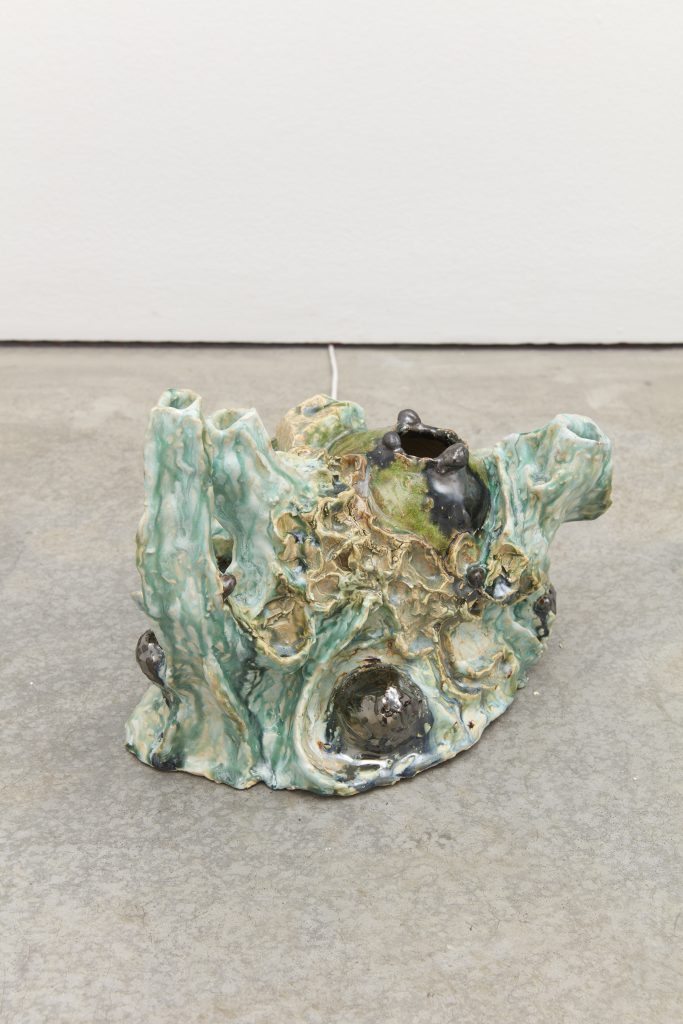
Heidi Lau, Cat Power Naps (2024). Photograph by Jason Wyche. © Heidi Lau. Courtesy of Matthew Brown and Sikkema Jenkins & Co.
These sculptures recall mingqi or spirit vessels, burial objects prevalent during the Eastern Han Dynasty. Taoist funerary rituals are a recurring motif in Liu’s practice, but rather than embodying concrete boundaries, Liu imagines death as something permeable. Her works become a place where the past and present intermingle.
“For me, these vessels can be a way of unlearning and understanding myself, and challenging accepted truths or colonial narratives we take for granted,” she told me, standing in front of her sculpture, Celadon Menagerie (2024). “In Shanhaijing, there are many tiny kingdoms where only women exist. The women populate their kingdom by drinking a drink that impregnates them. Stories like this are very anti-categorical, antilinear.”

Installation view “Heidi Lau: A Cacophony of Rocks” Sikkema Jenkins & Co., New York, 2024 Photograph by Jason Wyche. © Heidi Lau, courtesy of Matthew Brown and Sikkema Jenkins & Co.
Lau’s time-leaping, fertile vision is built through a synthesis of color and form. The delicate greens in many of her sculptures reference the ancient Chinese ceramics traditions with celadon slips. The hue also alludes to the artist’s home city of Macau, and its pastel-painted historic buildings. Pale pinks, meanwhile, are intended to impart “a fleshy softness.” These soft, gauzy tones are counterbalanced by a silvery gray-black, which Liu calls mercury. “The surfaces of my works can often seem to bubble up. In making these sculptures, I thought about mercury, the element that can change shape and come back together. That regenerative idea is very important to my work,” Lau explained.

Heidi Lau, Lighting A Fire With An Icicle (2024). Photograph by Jason Wyche. © Heidi Lau. Courtesy of Matthew Brown and Sikkema Jenkins & Co.
Biomorphic shapes are hidden in plain sight, too, vaginal imagery, and breasts intermingle among flowers and leaves. Hands emerge holding flames (perhaps a reference to the firing of ceramics themselves) and other times seemingly shaping the very clay from which they are formed.
Z—Lau’s ceramic vision of the dragon Zhulong–is the show’s centerpiece and hangs suspended from the ceiling of the exhibition’s second room. The dragon’s body is a long spine-like form made from small ceramic shapes Lau’s hand formed and ultimately strung together.
Surrounding the dragon are ceramic archways and tall totemic forms that create a garden-like space or even a cemeterial one. This transportive effect is embellished by experimental sounds that fill the gallery. The sounds emanate from speakers shrouded within ceramic sculptures placed on the floor (the immersive audio component of the show was developed in collaboration with Anchit Patni).
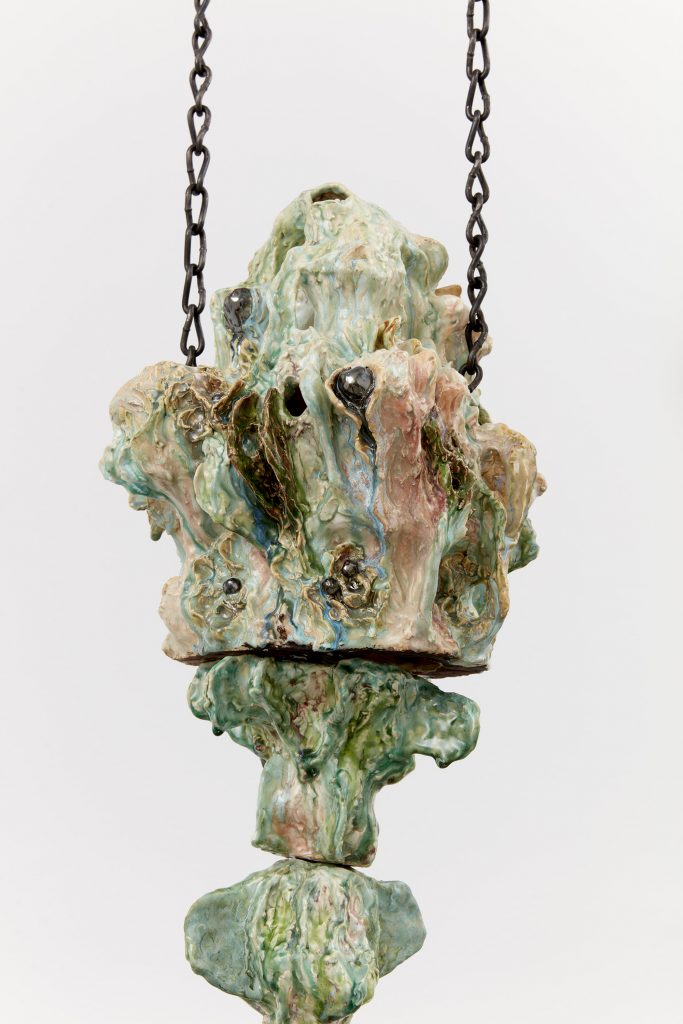
Detail of Z (2024) by Heidi Lau. Photograph by Jason Wyche. © Heidi Lau. Courtesy of Matthew Brown and Sikkema Jenkins & Co.
These works, and the sculpture Z in particular, offer Lau’s intimate reflections on her own experiences with mourning the death of her mother, who passed away from leukemia seven years ago.
“When the dragon opens and closes her eyes, she is controlling the rhythm of the universe. In a lot of ways that is like death, day in and day out,” said Lau “In that way, she reminds me of my mother and the burdens of motherhood. The sense of having to carry the world.”
Lau notes that the spinal shapes in her sculptures are a way of navigating her memories of her mother.
“My mother’s leukemia treatments were through her spine. Ever since then, I’ve been thinking about this shape. Here, the shapes have morphed into bigger structures,” she said. “I’ve personified family members before in my work, but never my mom. It always felt too soon. This was the first time I was able to inject my memories or feelings about her sickness and her struggles into my work.”
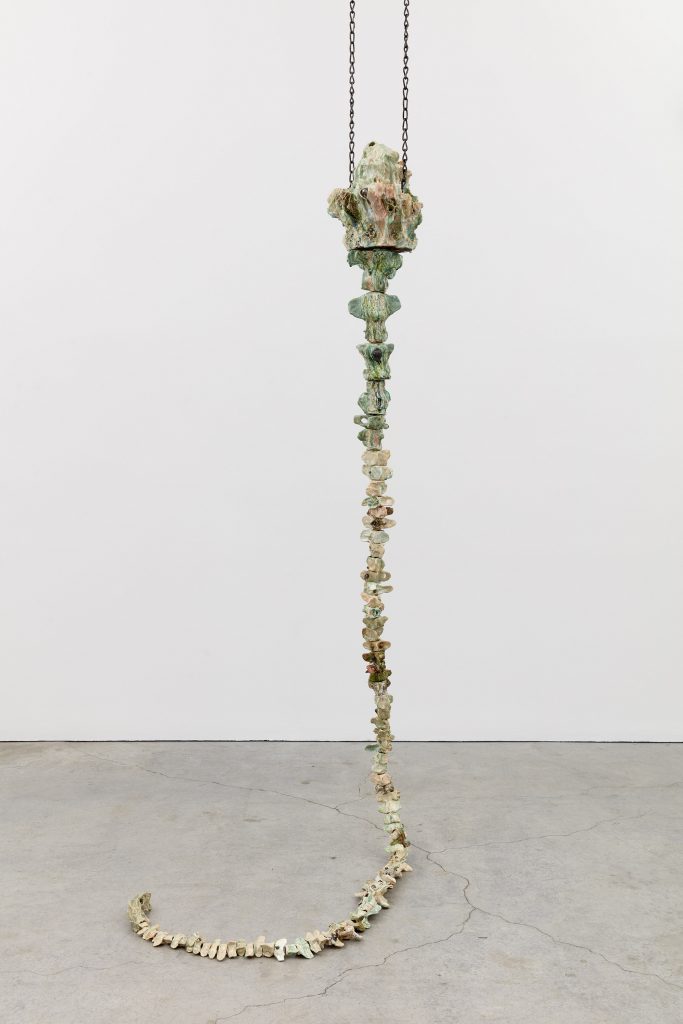
Heidi Lau, Z (2024). Photograph by Jason Wyche. © Heidi Lau. Courtesy of Matthew Brown and Sikkema Jenkins & Co.
The porousness of life and death, as well as time itself, feel potently alive in many of these sculptures. The sculptures can feel like portals able to carry us beyond the confines of corporeal existence and back to those we love.
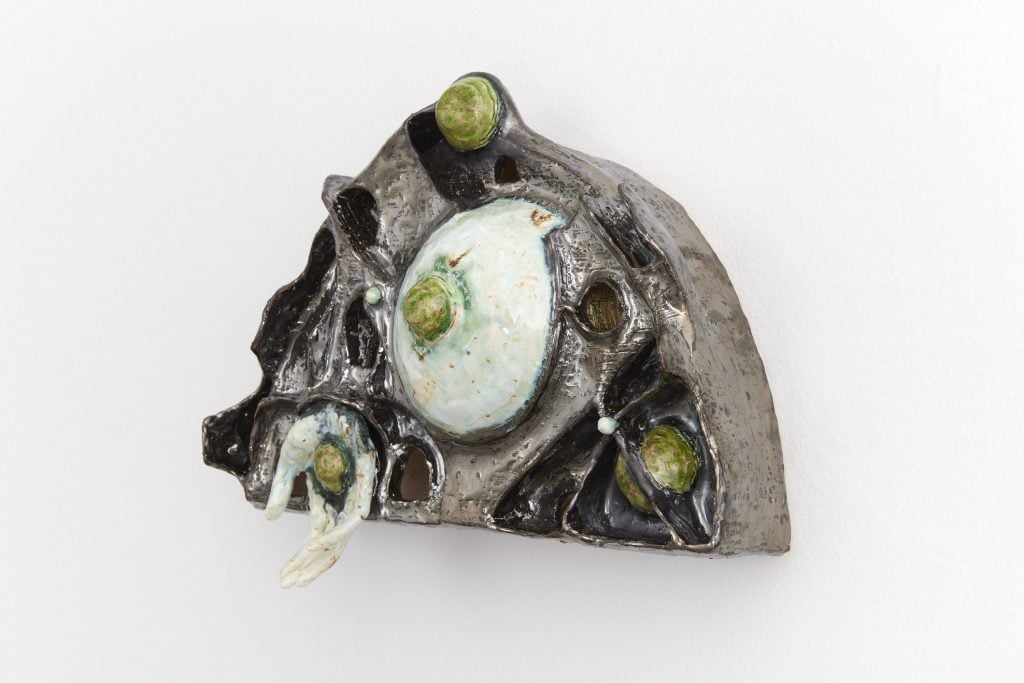
Heidi Lau, Waning Moon Pavillion (2023). Photograph by Jason Wyche. © Heidi Lau. Courtesy of Matthew Brown and Sikkema Jenkins & Co.
An arched sculpture, Waning Moon Pavillion, hangs above the doorway between the exhibition’s two rooms and beside the sculpture Z. A hand reaches down from the surface of the sculpture, holding an orb in its palm. Beside the hand, a pale round shape emerges, looking equal parts like a breast and a full moon.
“The moon has such important historical symbology, including family. It symbolizes change and the passage of time, but it is also a symbol of togetherness,” said Lau, “The dragon, she’s staring up at it, just like we are.”